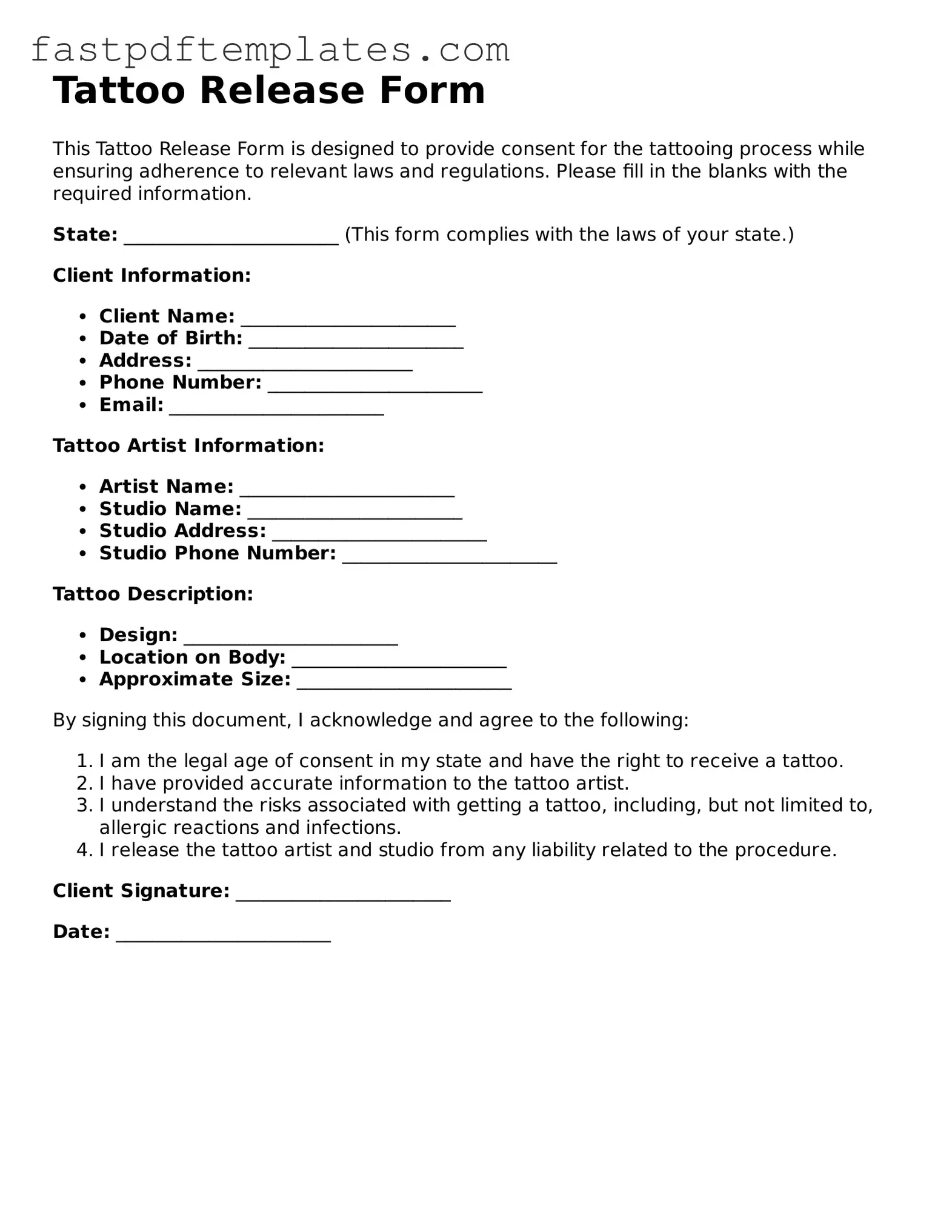The Tattoo Release form shares similarities with a Photography Release form. Both documents serve to protect the rights of the creator and the subject involved. In a Photography Release, the subject grants permission for their likeness to be captured and used in various media. Similarly, a Tattoo Release allows the tattoo artist to use images of the tattoo for promotional purposes, ensuring that both parties understand the usage rights associated with the artwork.
Another document akin to the Tattoo Release form is the Model Release form. This form is often used in fashion and advertising industries. Like the Tattoo Release, it allows the model to grant permission for their image to be used commercially. Both forms establish clear boundaries regarding the use of the individual's likeness, safeguarding the interests of the artist or photographer while ensuring the model's rights are respected.
The Consent Form for Medical Procedures is another comparable document. In medical settings, patients sign consent forms to acknowledge their understanding of the risks and benefits associated with a procedure. The Tattoo Release operates similarly, as it informs the client about the potential risks of getting a tattoo, including health concerns and the permanence of the artwork, thus ensuring that the client is making an informed decision.
A Video Release form also bears resemblance to the Tattoo Release. This document is used when individuals agree to have their image or voice recorded for video projects. Just as the Tattoo Release allows for the tattoo artist to showcase their work, a Video Release grants permission for the use of the individual’s appearance in the video, emphasizing the importance of consent in creative endeavors.
The Waiver of Liability form is another document that aligns closely with the Tattoo Release. A waiver is often signed to acknowledge the inherent risks associated with an activity. In the case of tattoos, the release form serves as a waiver, where the client acknowledges that they understand the risks involved in getting a tattoo and agrees not to hold the artist liable for any adverse outcomes.
In the realm of sports, the Participant Agreement form is similar to the Tattoo Release. Athletes often sign these agreements to acknowledge the risks of participation in sports activities. Likewise, clients sign a Tattoo Release to recognize the potential risks associated with getting a tattoo. Both documents highlight the importance of informed consent and the acknowledgment of risk by the participant.
The Release of Information form is another document that shares characteristics with the Tattoo Release. This form is commonly used in healthcare settings to allow for the sharing of a patient’s medical information. In a similar vein, the Tattoo Release allows the tattoo artist to share images of the tattoo, emphasizing the need for consent before any sharing occurs, whether it be medical records or artistic representations.
The Event Liability Release form also resembles the Tattoo Release. This document is often used in events where participants acknowledge the risks associated with their involvement. Just as attendees sign a liability release for events, clients sign a Tattoo Release to understand the risks related to getting a tattoo, thereby protecting the artist from potential legal claims.
The Release for Artwork Reproduction is another document that parallels the Tattoo Release. Artists often use this form to allow others to reproduce their artwork for various purposes. Similarly, a Tattoo Release grants the tattoo artist the right to reproduce images of the tattoo for marketing or portfolio use, ensuring that the artist's rights are protected while allowing for the promotion of their work.
Finally, the Non-Disclosure Agreement (NDA) can also be seen as similar to the Tattoo Release. While NDAs are primarily used to protect confidential information, they can also include clauses about the use of images and likenesses. A Tattoo Release, in a more straightforward manner, addresses the use of tattoo images and ensures that both the artist and client agree on how the artwork may be shared or displayed, emphasizing the importance of mutual consent in creative collaborations.
